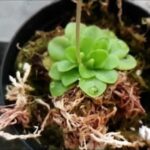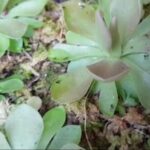As an Amazon Associate, this site earns commissions from qualifying purchases. For more details, click here.
Pinguicula cyclosecta is a small tropical butterwort found in many parts of Mexico. Its most distinguishing feature is the violet leaves that are tinged with blue-green. Caring for p. cyclosecta is easy especially if you have grown tropical butterworts before. If not, this guide will walk you through the essential steps.
Pinguicula cyclosecta needs at least 6 hours of full or partially shaded light. Water the plant regularly so the soil is always moist, and keep the humidity between 40-70%. Its leaves are replaced by succulent rosettes during winter.
Pinguicula Cyclosecta Care Sheet
| Soil | Equal parts vermiculite, perlite, silica |
| Water | Moist soil, purified, distilled water |
| Light | Partial light, full light if it is not too hot |
| Food | Small bugs, freeze dried bloodworms, mealworms, fish food |
| Temperature | 55-85 F (12.7 – 29.4 C) |
| Humidity | 40-70% |
| Dormancy | No, but enters a non-carnivorous phase in winter |
| Propagation | Leaf pullings |
Soil
The typical potting mix used for pinguicula cyclosecta is equal parts perlite, silica sand and vermiculite. Other media like peat and sphagnum moss may be used as well.
This potting mixture is standard for most butterworts including pinguicula grandiflora and other species. The soil is usually bundled with the plant when you purchase it. All you need to do is add purified or distilled water and the media is ready to use.
You might have seen others use different ratios like 2:1 or 3:1. You can try those but bear in mind that changing the composition will have a significant effect on the plant. That is why if you are starting out, it is better to use the soil mix that comes with your pinguicula.
Never use fertilized soil on your p. cyclosecta. If you are preparing a custom soil mix, avoid regular potting media. If the material is suitable for non-carnivorous plants, chances are it is not good for your ping. The label should indicate if the material is compatible with carnivorous plants. The Jungle House Potting Mix for example, is fully compatible with all carnivorous plants.
Pot Container
A mature p. cyclosecta measures 2.5 inches, so a 3.5 inch pot is recommended. You can use a taller container, but these butterworts have short roots so it is not needed.
When you buy p. cyclosecta it will probably be wrapped in paper towels. First you should pour the soil into a pot. Now carefully unwrap the paper towel and take out your butterworts. Plant it in the pot as you would any other pinguicula.
Because p. cyclosecta is small, it is possible to plant several of them in one large container. If you do so, make sure there is sufficient soil. Drainage is important especially if you are planting pinguicula on rocks. In general you can use just about any type of pot, but do make sure it is durable.
Water
Water consistently from spring to summer so the soil is always moist. Reduce watering in winter when its carnivorous leaves are replaced by succulent rosettes.
Some Mexican butterworts prefer the tray method, but overhead watering may be sufficient for p. cyclosecta. If watering from the top keeps the potting media moistened, there is no need for the tray. But if you find yourself watering constantly to prevent dryness, you should give it a try.
The tray method means letting a potted plant sit in a container full of water. Well, not exactly full, about 1-2 inches deep. With p. cyclosecta you should use only an inch or less of water because of its size. While its soil has to be constantly moist, its fragile roots are prone to rotting.
Butterworts need clean, mineral free water. Tap water is a no-no so use Snugell Distilled Water or purified water instead. If you are watering from the top, spray freely and not in a single area.
Water as often as necessary to prevent the soil from drying up. During winter, scale back on watering and let the soil dry. Even though the plant does not go dormant, its activities slow down. It does not need as much light or water compared to spring and summer.
Light
At least 6 hours of sunlight is required. Pinguicula cyclosecta grows well under partial shade but will also thrive in full light. Full morning light is the best because the sun can get really hot by midday.
Light is a must for all tropical butterworts. While they get nutrition from insects, glucose is their actual food. To create glucose, these plants need sunlight. Butterworts can live without bugs but not light.
You can leave the plant on a sunny window bay and let it soak the morning light. If you are using the tray method, the water will increase the humidity level even if the temperature rises.
Butterworts produce intense colors under light, and this is normal. However too much dries out the mucilage on its leaves. Without it there is no way the plant can catch and eat prey. This is why you have to partially cover p. cyclosecta during intense heat.
Grow lights. P. cyclosecta can be cultivated indoors with grow lights. Position the light about 12 inches from the plant. A good quality light will do the job well. Use the light as if it were sunlight, that is from morning until late afternoon. This is necessary so your butterworts can follow its natural cycle.
Temperature
Mexican butterworts prefer mild temperature and p. cyclosecta is no exception. The ideal range is 55-85 F (12.7-29.4 C), These plants are not cold temperate and they cannot withstand prolonged winter frosting.
The range given above applies to most other Mexican butterworts as well. But other factors affect pinguicula growth like water, soil, humidity, food etc. If your ping grows in a healthy environment, it should withstand higher and colder temperatures. If your plant is in an unsuitable setting, it will eventually die.
The nice thing about p cyclosecta is its ability to adapt. For a small plant it copes well in different conditions. However you should try to keep the plant within the given range so it will thrive.
A few degrees higher or lower above the given range will not harm your ping. With enough water, light and humidity, it will be fine. But if the weather starts getting really cold or regularly climbs over 100 F, it is time to increase humidity and partially shade your pinguicula.
Humidity
A humidity level of 40-70% is enough. Air circulation is the key here. There must be sufficient air flow no matter what the humidity rate is. This is essential because humidity plays a big role in producing mucus for its leaves.
If you have pinguicula esseriana- a really easy ping to grow – you will notice its humidity requirement is somewhat higher. Like most Mexican butterworts it thrives in at least 50% and even up to 80%.
The higher the humidity level, the more water is in the air. This makes for a very conducive environment for producing mucus. If your pinguicula is not sticky, a humidity boost can help.
Feeding and Nutrition
Pinguicula cyclosecta feasts on small insects, dried bloodworms and fish betta pellets. Feed every couple of weeks. You only need to drop small amounts of food on a leaf or two. That will be enough for the plant.
Some use fertilizers as food. While you should not put any on the soil, you may fertilize ping leaves with a very diluted mix. The most widely used is Maxsea, typically 1/4 teaspoon for every gallon of water. Because p. cyclosecta is delicate, you have to use even less fertilizer compared to other butterworts. If the plant is healthy and gets to eat a lot of bugs, fertilizer is not necessary.
Dormancy
Pinguicula cyclosecta turns into a non-carnivorous plant in winter. The plant starts to discard its leaves in the fall and by winter, it will have transformed into a succulent rosette.
Strictly speaking, p. cyclosecta does not enter dormancy. Dormancy means shedding leaves and forming a hibernacula in winter. For this reason this is called a dry dormancy or succulent phase.
As your ping drops its carnivorous leaves, slowly reduce watering. Let the soil go dry for days when its winter rosette has formed. It is all right to mist the soil a little, but not as much as in spring or summer.

My fascination with carnivorous plants began many, many years ago with Venus Fly Traps. Now I am more than happy to impart what I know with other enthusiasts and those who are curious about meat eating plants.



